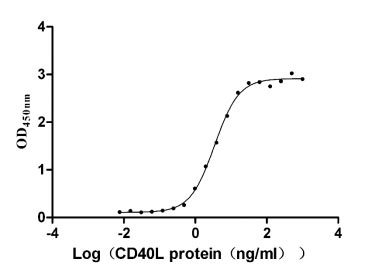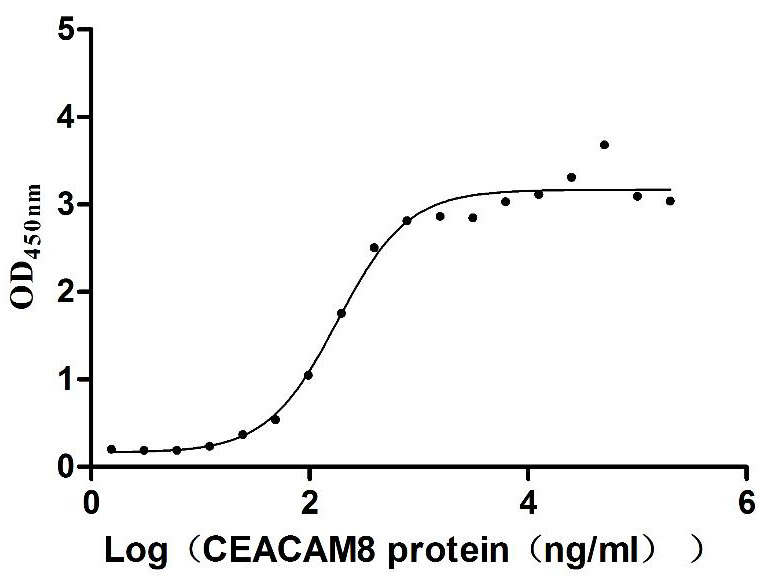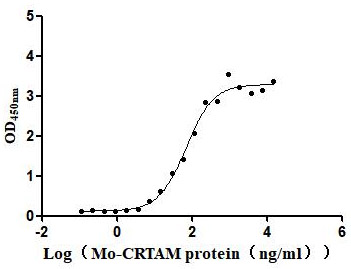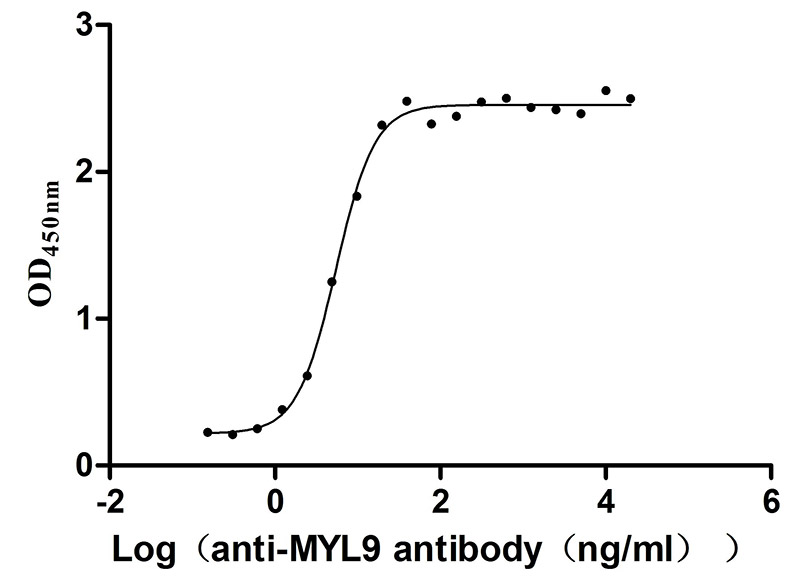Recombinant Mouse Short transient receptor potential channel 2 (Trpc2), partial
-
中文名稱:小鼠Trpc2重組蛋白
-
貨號:CSB-YP874183MO
-
規(guī)格:
-
來源:Yeast
-
其他:
-
中文名稱:小鼠Trpc2重組蛋白
-
貨號:CSB-EP874183MO
-
規(guī)格:
-
來源:E.coli
-
其他:
-
中文名稱:小鼠Trpc2重組蛋白
-
貨號:CSB-EP874183MO-B
-
規(guī)格:
-
來源:E.coli
-
共軛:Avi-tag Biotinylated
E. coli biotin ligase (BirA) is highly specific in covalently attaching biotin to the 15 amino acid AviTag peptide. This recombinant protein was biotinylated in vivo by AviTag-BirA technology, which method is BriA catalyzes amide linkage between the biotin and the specific lysine of the AviTag.
-
其他:
-
中文名稱:小鼠Trpc2重組蛋白
-
貨號:CSB-BP874183MO
-
規(guī)格:
-
來源:Baculovirus
-
其他:
-
中文名稱:小鼠Trpc2重組蛋白
-
貨號:CSB-MP874183MO
-
規(guī)格:
-
來源:Mammalian cell
-
其他:
產品詳情
-
純度:>85% (SDS-PAGE)
-
基因名:Trpc2
-
Uniprot No.:
-
別名:Trpc2; Trp2; Trrp2; Short transient receptor potential channel 2; TrpC2; Transient receptor protein 2; TRP-2; mTrp2
-
種屬:Mus musculus (Mouse)
-
蛋白長度:Partial
-
蛋白標簽:Tag?type?will?be?determined?during?the?manufacturing?process.
The tag type will be determined during production process. If you have specified tag type, please tell us and we will develop the specified tag preferentially. -
產品提供形式:Lyophilized powder
Note: We will preferentially ship the format that we have in stock, however, if you have any special requirement for the format, please remark your requirement when placing the order, we will prepare according to your demand. -
復溶:We recommend that this vial be briefly centrifuged prior to opening to bring the contents to the bottom. Please reconstitute protein in deionized sterile water to a concentration of 0.1-1.0 mg/mL.We recommend to add 5-50% of glycerol (final concentration) and aliquot for long-term storage at -20℃/-80℃. Our default final concentration of glycerol is 50%. Customers could use it as reference.
-
儲存條件:Store at -20°C/-80°C upon receipt, aliquoting is necessary for mutiple use. Avoid repeated freeze-thaw cycles.
-
保質期:The shelf life is related to many factors, storage state, buffer ingredients, storage temperature and the stability of the protein itself.
Generally, the shelf life of liquid form is 6 months at -20°C/-80°C. The shelf life of lyophilized form is 12 months at -20°C/-80°C. -
貨期:Delivery time may differ from different purchasing way or location, please kindly consult your local distributors for specific delivery time.Note: All of our proteins are default shipped with normal blue ice packs, if you request to ship with dry ice, please communicate with us in advance and extra fees will be charged.
-
注意事項:Repeated freezing and thawing is not recommended. Store working aliquots at 4°C for up to one week.
-
Datasheet :Please contact us to get it.
靶點詳情
-
功能:Thought to form a receptor-activated non-selective calcium permeant cation channel. Probably is operated by a phosphatidylinositol second messenger system activated by receptor tyrosine kinases or G-protein coupled receptors. May also be activated by intracellular calcium store depletion. Plays a role in mediating responsivity to pheromones that elicit aggressive and mating behaviors. Required for response to the Esp1 pheromone which enhances female sexual receptive behavior and to the Esp22 pheromone which inhibits adult male mating behavior.
-
基因功能參考文獻:
- Nucleus accumbens dopamine signaling regulates sexual preference for females in male mice via Trpc2. PMID: 29241537
- Low oxygen induces calcium influx in a subpopulation of olfactory epithelium neurons, and Gucy1b2 and Trpc2 are required for these responses. PMID: 27916458
- The Trpc2(-/-) males housed under isolated conditions spent significantly longer in the vicinity of pups than did the Trpc2(-/-) males than had been group housed, whereas no isolation effect was observed in heterozygous Trpc2(+/-) males. PMID: 27840094
- Authors show that TrpC2(-/-) males were able to acquire aversion to female-soiled bedding and presented similar behavioral alterations following COA in their responses to female cues. PMID: 27535696
- Two types of neurons in the main olfactory epithelium express Trpc2. PMID: 25001287
- The data demonstrate that TRPC2 plays an important role in oxidative stress-induced hemolysis, which may be related to reduced calcium entry in red cells in the presence of Trpc2 depletion. PMID: 21924222
- In the medial and basolateral amygdala, KO mice showed a robust Fos response to bedding, suggesting that regions of the amygdala canonically associated with pheromonal sensing can be active in the brains of KO mice. PMID: 21070815
- These data suggest that both diacylglycerol and its metabolite, arachidonic acid, mediate excitatory odor responses in the vomeronasal organ, by activating two types of channels, a TRPC2 and a separate Ca(2+)-permeable channel. PMID: 20147653
- Loss of the Trpc2 gene severely diminishes maternal aggression. Deletion of the gene results in differential hypotrophy of the glomerular layer of the AOB. PMID: 19799641
- required for the sensory activation of vomeronasal organ neurons; Male mice deficient in TRP2 expression fail to display male-male aggression, and they initiate sexual and courtship behaviors toward both males and females. PMID: 11823606
- Altered sexual and social behaviors in trp2 mutant mice PMID: 11972034
- Erythropoietin modulates calcium influx through TRPC2. PMID: 12167663
- TRPC2 is alternatively spliced and encodes an active calcium channel in mouse PMID: 12601176
- TRPC2 and TRPC6 interact and have roles in erythropoietin modulation of calcium influx PMID: 14699131
- Epo-R, TRPC2, PLCgamma, and IP(3)R interact to form a signaling complex. PMID: 15329338
- a short splice variant of TRPC2 exists in many cell types, which associates with and modifies activity of TRPC2 splice variants. PMID: 15589997
- the N-terminus of junctate interacts with the C-terminus of TRPC2 PMID: 16153633
- Results describe a previously unrecognized TRPC2-independent signal transduction mechanism in the vomeronasasl organ that underlies the sensing of cues required for the formation of pheromonal mate-recognition memory. PMID: 16820028
- Trpc2-/- female mice show a reduction in female-specific behaviour, and mutant females display unique characteristics of male sexual and courtship behaviours PMID: 17676034
- channel expressed specifically in sensory microvilli of the vomeronasal organ and likely to mediate pheromone sensory transduction. PMID: 10318963
顯示更多
收起更多
-
亞細胞定位:Membrane; Multi-pass membrane protein.
-
蛋白家族:Transient receptor (TC 1.A.4) family, STrpC subfamily, TRPC2 sub-subfamily
-
組織特異性:Isoform 3 is ubiquitously expressed at low levels. Isoform 4 is expressed exclusively in vomeronasal organ.
-
數據庫鏈接:
Most popular with customers
-
Recombinant Human Tumor necrosis factor receptor superfamily member 5 (CD40), partial (Active)
Express system: Mammalian cell
Species: Homo sapiens (Human)
-
Recombinant Human Tumor necrosis factor ligand superfamily member 18 (TNFSF18), partial (Active)
Express system: Mammalian cell
Species: Homo sapiens (Human)
-
Recombinant Mouse Tyrosine-protein kinase Mer (Mertk), partial (Active)
Express system: Mammalian cell
Species: Mus musculus (Mouse)
-
Recombinant Human Microtubule-associated protein tau (MAPT) (Active)
Express system: Mammalian cell
Species: Homo sapiens (Human)
-
Express system: Mammalian cell
Species: Homo sapiens (Human)
-
Recombinant Human Carcinoembryonic antigen-related cell adhesion molecule 6 (CEACAM6) (Active)
Express system: Mammalian cell
Species: Homo sapiens (Human)
-
Recombinant Mouse Cell adhesion molecule 1 (Cadm1), partial (Active)
Express system: Mammalian cell
Species: Mus musculus (Mouse)
-
Recombinant Human Myosin regulatory light polypeptide 9 (MYL9) (Active)
Express system: Yeast
Species: Homo sapiens (Human)





-AC1.jpg)













